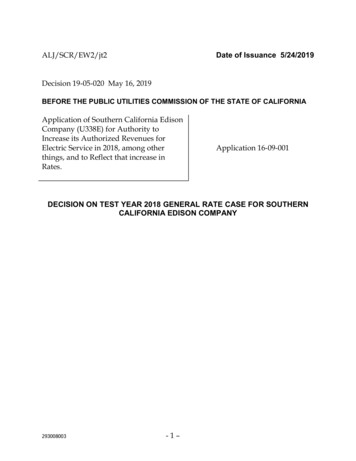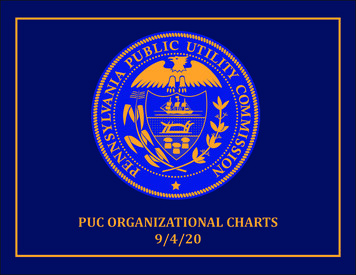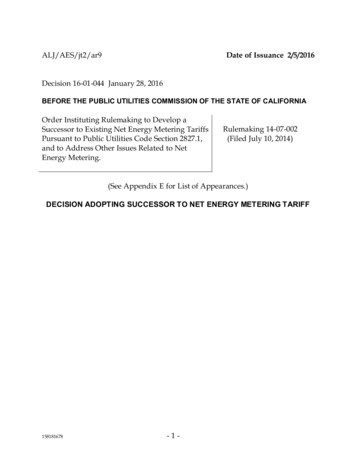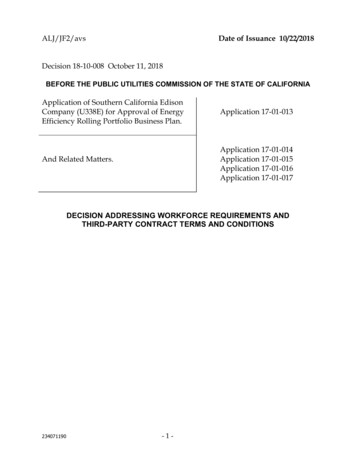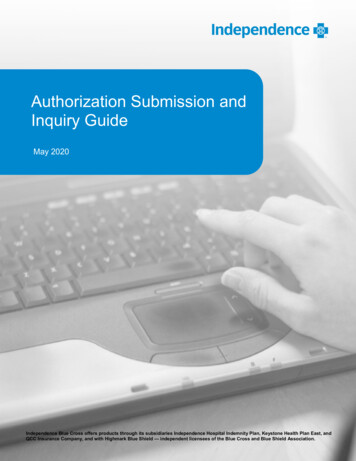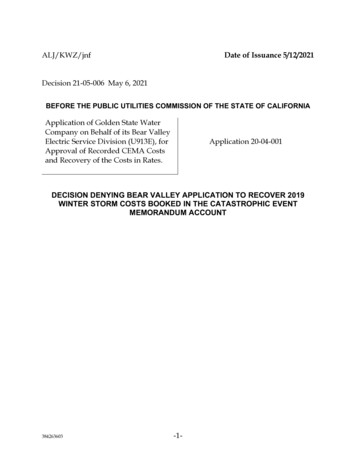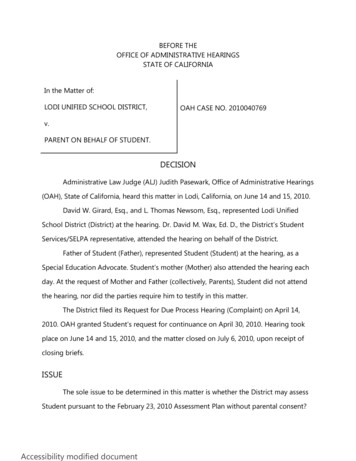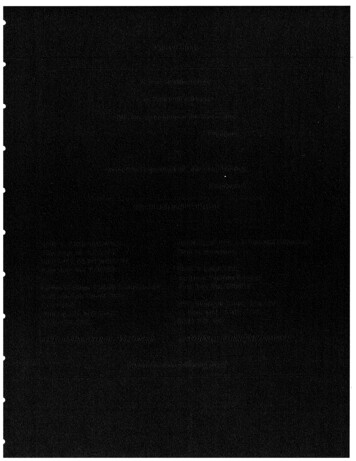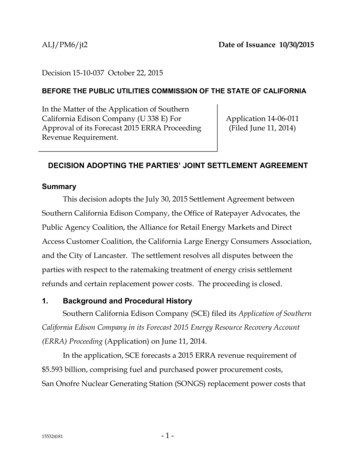
Transcription
ALJ/PM6/jt2Date of Issuance 10/30/2015Decision 15-10-037 October 22, 2015BEFORE THE PUBLIC UTILITIES COMMISSION OF THE STATE OF CALIFORNIAIn the Matter of the Application of SouthernCalifornia Edison Company (U 338 E) ForApproval of its Forecast 2015 ERRA ProceedingRevenue Requirement.Application 14-06-011(Filed June 11, 2014)DECISION ADOPTING THE PARTIES’ JOINT SETTLEMENT AGREEMENTSummaryThis decision adopts the July 30, 2015 Settlement Agreement betweenSouthern California Edison Company, the Office of Ratepayer Advocates, thePublic Agency Coalition, the Alliance for Retail Energy Markets and DirectAccess Customer Coalition, the California Large Energy Consumers Association,and the City of Lancaster. The settlement resolves all disputes between theparties with respect to the ratemaking treatment of energy crisis settlementrefunds and certain replacement power costs. The proceeding is closed.1.Background and Procedural HistorySouthern California Edison Company (SCE) filed its Application of SouthernCalifornia Edison Company in its Forecast 2015 Energy Resource Recovery Account(ERRA) Proceeding (Application) on June 11, 2014.In the application, SCE forecasts a 2015 ERRA revenue requirement of 5.593 billion, comprising fuel and purchased power procurement costs,San Onofre Nuclear Generating Station (SONGS) replacement power costs that155324181-1-
A.14-06-011 ALJ/PM6/jt2SCE incurred during extended outages,1 balances that SCE proposed to return tocustomers as a result of settlement refunds from the 2000-2001 California EnergyCrisis,2 and other miscellaneous expenses, such as spent nuclear fuel expense andDepartment of Energy decontamination and decommissioning fees. The revenuerequirement forecast is based upon SCE’s best estimate of such factors askilowatt hour sales and load, natural gas and power prices, and an estimate ofthe December 31, 2014 balancing account balances.SCE requested that the Commission adopt its: (1) 2015 forecast revenuerequirement; (2) electric sales forecast; (3) rate increase proposals; (4) proposedrecovery of year-end ERRA balances for 2014; (5) proposed recovery of netSONGS-related “replacement power” costs incurred in 2013 that were deferredfrom inclusion in in previous ERRA revenue forecasts, and (6) find that its inputsand calculation of the power charge indifference allowance (PCIA), ongoingcompetition transition charge and Cost Allocation Methodology forecasts arereasonable and accurate.In testimony filed with its Application, SCE described the methodology itused to determine the 2015 Cost Responsibility Surcharge (CRS) for DirectAccess (DA), Departing Load and Community Choice Aggregation customers,collectively DA-CRS.As a result of the Commission’s approval of the SONGS Order InstitutingInvestigation (OII) Settlement on November 20, 2014 in Decision (D.) 14-11-040,SCE also proposed to: (1) modify the 2012 general rate case Phase I revenueSCE removed approximately 467 million in 2013 net SONGS costs from its ERRA rates anddeferred them for consideration in the SONGS OII. Now that the SONGS SettlementAgreement has been approved, SCE seeks to recover this amount in its ERRA rates.12SCE’s forecast includes approximately 204 million in such energy crisis settlement refunds.-2-
A.14-06-011 ALJ/PM6/jt2requirement, to reflect recovery at the reduced rate of return outlined in thesettlement; (2) refund revenues collected after February 1, 2012 that exceed therevenue authorized under the reduced rate of return outlined therein; and(3) include 467 million in net SONGS-related costs that were incurred in 2013and deferred from inclusion in previous ERRA revenue requirement forecasts inthe PCIA for purposes of this 2015 forecast.SCE proposed to omit balances of the Base Revenue RequirementBalancing Account, the Nuclear Decommissioning Adjustment Mechanism, theCalifornia Alternate Rates for Energy balancing Account, and the Public PurposePrograms Adjustment Mechanism from future ERRA proceedings and insteadinclude them in its annual revenue requirement and rate consolidation adviceletter.SCE’s 2015 forecast included refunds of 204 million that it had receivedfrom generators who overcharged SCE for electricity during the 2000-2001California Energy Crisis. Refunds received were placed into the EnergySettlements Memorandum Account (ESMA).3No party objected to SCE’s proposed revenue requirement or its proposedtreatment of balancing accounts. However, some parties disputed SCE’sproposed treatment of energy settlement refunds from the 2000-2001 CaliforniaEnergy Crisis and SCE’s proposal to include SONGS replacement power costs inthe PCIA.An evidentiary hearing was held on November 4, 2014, at which theparties had an opportunity to cross examine witnesses testifying on behalf of3Ten percent of the refunds are retained by SCE to cover legal expenses associated withrecovery of the refunds. The remaining 90% are refunded to bundled service customers.-3-
A.14-06-011 ALJ/PM6/jt2SCE, Alliance for Retail Energy Markets/ Direct Access Customer Coalition(AReM/DACC) and Public Agency Coalition (PAC).4The assigned Administrative Law Judge (ALJ) issued a Proposed Decision(PD) on December 30, 2014. Commission President Michael Picker issued anAlternate Proposed Decision (APD) on February 24, 2015. On June 15, 2015, SCEfiled a Motion to Set Aside Submission of the Proceeding in order to permit theparties to explore informal resolution of their disputes. On June 23, 2015, the ALJgranted the Motion. The parties filed a Motion for Approval of their SettlementAgreement on July 30, 2015. No party opposes the Settlement Agreement.2.The Settlement2.1.Resolution of the Parties’ Dispute ConcerningTreatment of Energy Settlement RefundsFrom the 2000-2001 California Energy CrisisAReM/DACC and PAC contended that DA customers should receive13.9% of the refunds in the ESMA and that the share of refunds credited to DAcustomers should be included in the Total Portfolio Cost element used in thecalculation of the PCIA.5 Lancaster argued that Community Choice Aggregation(CCA) customers should receive the same share of the refunds that bundledservice customers receive. SCE argued that precedent and fairness mandatedthat the refunds flow only to SCE’s bundled service customers.Robert Thomas (Manager of Rate Design in Regulatory Operations) and Douglas Snow(Director of Revenue Requirements & Tariffs in State Regulatory Operations) testified on behalfof SCE. Mark Fulmer, Principal at MRW & Associates, LLC testified on behalf of AReM, DACCand PAC.4AReM, DACC and PAC argued that the credits were tied to SCE’s excessive procurementrelated obligations due to excessive prices charged SCE by the California Power Exchange. TheCommission’s D.03-09-016 set forth a calculation attributing a 13.9% portion of SCE’sprocurement related liability to DA customers.5-4-
A.14-06-011 ALJ/PM6/jt2In their Settlement, SCE, Office of Ratepayer Advocates (ORA), PAC,AReM-DACC, California Large Energy Consumers Association (CLECA), andLancaster (collectively the Settling Parties), agree that DA customers will receive10.05% of the 2014 net energy crisis refunds and that CCA customers will receivethe share that they would have received had they continued to remain bundledservice customers.6 The Settling Parties contend that this is a reasonablecompromise within the range of litigation positions and outcomes contemplatedby the PD and APD. The Settling Parties indicate that they intend that thistreatment of the energy crisis refunds apply “going forward” to such futurerefunds.2.2.Resolution of the Parties’ Dispute ConcerningSONGS Replacement Power Costs in the PCIAAReM, DACC and PAC also objected to SCE’s proposal to include SONGSreplacement power costs in the PCIA forecast. The objecting parties concededthat the Consensus Protocol7 indicates that it “would govern how a ratemakingsurcharge would be incorporated into the PCIA to allow for recovery of theappropriate share of these costs from DA customers at the appropriate time,”however, they contended that the DA customer’s appropriate share of theSONGS replacement power costs is actually zero.86See Settlement Agreement at A-8.7In D.14-05-003, the Commission approved the “Direct Access Customer RatemakingConsensus Protocol for the SONGS Outages and Retirement,” which is commonly referred to asthe “Consensus Protocol.”8They reasoned that the PCIA is designed to ensure that bundled customers are “indifferent”,i.e., that DA customers pay the PCIA to cover the above-market costs of generation assetsowned. However, they argued that short-term and market purchases made by SCE to serve itsFootnote continued on next page-5-
A.14-06-011 ALJ/PM6/jt2SCE contended that the Consensus Protocol mandated that DA customerportfolio costs (which determine the PCIA that such customers pay to SCE)reflect the same upwards and downwards adjustments that apply to bundledservice customers.In their Settlement Agreement, the Settling Parties agreed that DA andCCA customers’ portfolio costs should be adjusted upwards by 462 million9 anddownwards by 506 million.103.Settlement Standard of ReviewIn order for the Commission to consider a proposed settlement in thisproceeding as being in the public interest, the Commission must be convincedthat the Settling Parties have a sound and thorough understanding of theapplication and all of the underlying assumptions and data included in therecord. This level of understanding of the application and development of anadequate record is necessary to meet our requirements for considering anysettlement. These requirements are set forth in Commission Rules of Practiceand Procedure (Rules) Rule 12.1(a).11 The Commission will not approvesettlements, whether contested or uncontested, unless the settlement isreasonable in light of the whole record, consistent with the law, and in the publicbundled load (which were not entered into on behalf of departed DA customers), are notincluded in the PCIA stranded cost calculation, nor should SONGS replacement power costs.9This adjustment relates to 2013 net SONGS costs.10See Settlement Agreement at A-6. This adjustment reflects a base rates revenue requirementrelated refund as called for by the SONGS OII Settlement Agreement and the ConsensusProtocol.All subsequent Rules refer to the Commission’s Rules of Practice and elawspolicies.htm11-6-
A.14-06-011 ALJ/PM6/jt2interest. Rule 12.5 limits the future applicability of a settlement,12 therefore, theCommission must also consider whether it is appropriate to handle futureenergy crisis refunds in the manner that Settling Parties intend.In short, we must find whether the settlement satisfies Rule 12.1(d), whichrequires a settlement to be “reasonable in light of the whole record, consistentwith law, and in the public interest.” As stated below, this settlement meets thethree requirements.3.1.The Settlement Meets the Standard of Reviewfor SettlementThe record consists of the filed application with attached documents, theSettlement Agreement and the motion for its adoption. The settlement resolvesthe concerns that the parties raised in their protests or responses, addresses theissues within the scoping memorandum and provides sufficient information topermit the Commission to discharge its regulatory obligations. The settlement isunopposed.The settlement can be said to serve the public interest because resolvingthe protest is the result of negotiation by parties who have a thoroughunderstanding of the issues and can make informed decisions in the settlementprocess. The settlement overall is reasonable in light of the record and serves thepublic interest by resolving competing concerns in a collaborative andcooperative manner. By reaching agreement, the parties also avoid the costs offurther litigation.Rule 12.5 “Commission adoption of a settlement is binding on all parties to the proceeding inwhich the settlement is proposed. Unless the Commission expressly provides otherwise, suchadoption does not constitute approval of, or precedent regarding, any principle or issue in theproceeding or in any future proceeding.”12-7-
A.14-06-011 ALJ/PM6/jt23.2.Future Effect of Settlement on Allocation ofNet Energy Crisis RefundsRule 12.5 limits the future applicability of a settlement. Under Rule 12.5,adoption of a settlement does not constitute precedent or have binding effectregarding any principle or issue in any future proceeding, unless theCommission expressly provides otherwise. Issues concerning the allocation ofNet Energy Crisis Refunds were a key aspect of the Settling Parties dispute. Hadthe parties been unable to settle this aspect of their dispute, it is possible that thisproceeding would have continued to a Phase 2 proceeding and that the partieswould have become embroiled in litigation into the future. By reachingagreement about how Net Energy Crisis Refunds will be allocated between DA,CCA and bundled customers, in this proceeding, the Settling Parties avoidedtime and cost of further litigation. By agreeing that the allocation should beapplied “going forward” the Settling Parties demonstrate intent to avoid futuredisputes and litigation concerning this issue in future proceedings. While thisCommission cannot make a commitment to bind future Commissions to thesame outcome, we interpret Section III-B-9 of the Settlement Agreement as acommitment between the parties to follow this approach in future ratemakingadjustments of Net Energy Crisis Refunds. Such a commitment willundoubtedly be helpful, should similar issues resurface.3.3.Effect of Settlement on 2015 ForecastRevenue Requirement Rate IncreaseProposalsSCE’s ERRA electric procurement cost revenue requirement forecast of 5.593 billion was approximately 437 million higher than the 2014 forecast-8-
A.14-06-011 ALJ/PM6/jt2revenue requirement in SCE’s 2014 ERRA forecast.13 It included a request for arate increase due, in part, to increases in: (1) its bundled customer load forecast;(2) its purchase of short-term power; (3) renewable procurement costs; (4) naturalgas prices; and (5) average on-peak power prices.SCE’s Motion to Set Aside Submission of the Proceeding, once granted,also set aside consideration of this Commission’s approval of any rate increasesupported by the higher 2015 forecast revenue requirement. Thus, the revenuerequirement approved in D.14-05-003 will remain in effect until SCE’s 2016ERRA forecast revenue requirement is resolved.144.Waiver of Comment PeriodGiven the Settlement Agreement, this matter is now uncontested andgrants the relief requested. Therefore, the otherwise applicable 30-day period forpublic review is waived pursuant to Pub. Util. Code § 311(g)(2) and Rule14.6(c)(2 of the Commission’s Rules of Practice and Procedure.5.Assignment of ProceedingMichel P. Florio is the Assigned Commissioner and Patricia B. Miles is theassigned ALJ in this proceeding.Findings of Fact1. On June 11, 2014, SCE filed Application 14-06-011 for approval of itsforecast 2015 ERRA Proceeding Revenue Requirement.13SCE’s Application (A.) 13-08-004 regarding its 2014 ERRA forecast revenue requirement wasapproved in D.14-05-003, adopted May 1, 2014.SCE’s Application A.15-05-007 for Approval of its Forecast 2016 ERRA ProceedingRevenue Requirement was filed May 1, 2015, and is currently under review.14-9-
A.14-06-011 ALJ/PM6/jt22. On July 21, 2014, ORA filed a protest to the application and AReM-DACCand PAC filed responses to the application.3. The assigned ALJ issued a PD on December 30, 2014. CommissionPresident Michael Picker issued an APD on February 24, 2015.4. On June 15, 2015, SCE filed a Motion to Set Aside Submission of theProceeding in order to permit the parties to explore informal resolution of theirdisputes. On June 23, 2015, the ALJ granted the Motion to Set Aside Submissionof the Proceeding.5. SCE’s Motion to Set Aside Submission of the Proceeding ended thisCommission’s approval of any potential rate increase supported by a higher 2015forecast revenue requirement.6. On July 30, 2015, SCE filed a Motion for Approval of SettlementAgreement Between and Among SCE, ORA, PAC, AReM-DACC, CLECA andLancaster. The Settlement Agreement resolves the concerns that were raised inthe protests and responses to the application, and issues addressed in commentsto the PD and APD.7. The record for approval of the Settlement Agreement is composed of theapplication, documents attached to the application, the motion for approval ofthe Settlement Agreement and its attachments.8. The parties to the settlement have a sound and thorough understanding ofthe issues and are therefore able to make informed decisions about the settlementprocess.9. The proposed settlement is reasonable in light of the record, consistentwith the law and in the public interest.- 10 -
A.14-06-011 ALJ/PM6/jt2Conclusions of Law1. The July 30, 2015 motion filed by SCE to adopt the Settlement Agreementbetween and among SCE, ORA, PAC, AReM-DACC, CLECA and Lancastershould be granted.2. The settlement resolves all disputes between the parties with respect tothe Application and addresses all comments filed by parties on the PD andAPDs.3. The rate increase approved in D.14-05-003 will remain in effect until SCE’s2016 ERRA forecast revenue requirement is approved.4. The proceeding should be closed.O R D E RIT IS ORDERED that:1. The Settlement Agreement filed on July 30, 2015 Between and AmongSouthern California Edison Company, The Office of Ratepayer Advocates, ThePublic Agency Coalition, The Alliance For Retail Energy Markets and the DirectAccess Customer Coalition, The California Large Energy Consumers Associationand the City of Lancaster (Settlement), is approved. The Settlement is attached tothis decision as Attachment A.- 11 -
A.14-06-011 ALJ/PM6/jt22. Application 14-06-011 is closed.This order is effective today.Dated October 22, 2015, at Sacramento, California.MICHAEL PICKERPresidentMICHEL PETER FLORIOCATHERINE J.K. SANDOVALCARLA J. PETERMANLIANE M. RANDOLPHCommissioners- 12 -
(3) include 467 million in net SONGS-related costs that were incurred in 2013 and deferred from inclusion in previous ERRA revenue requirement forecasts in the PCIA for purposes of this 2015 forecast. SCE proposed to omit balances of the Base Revenue Requirement Balancing Account, the Nuclear Decommissioning Adjustment Mechanism, the
